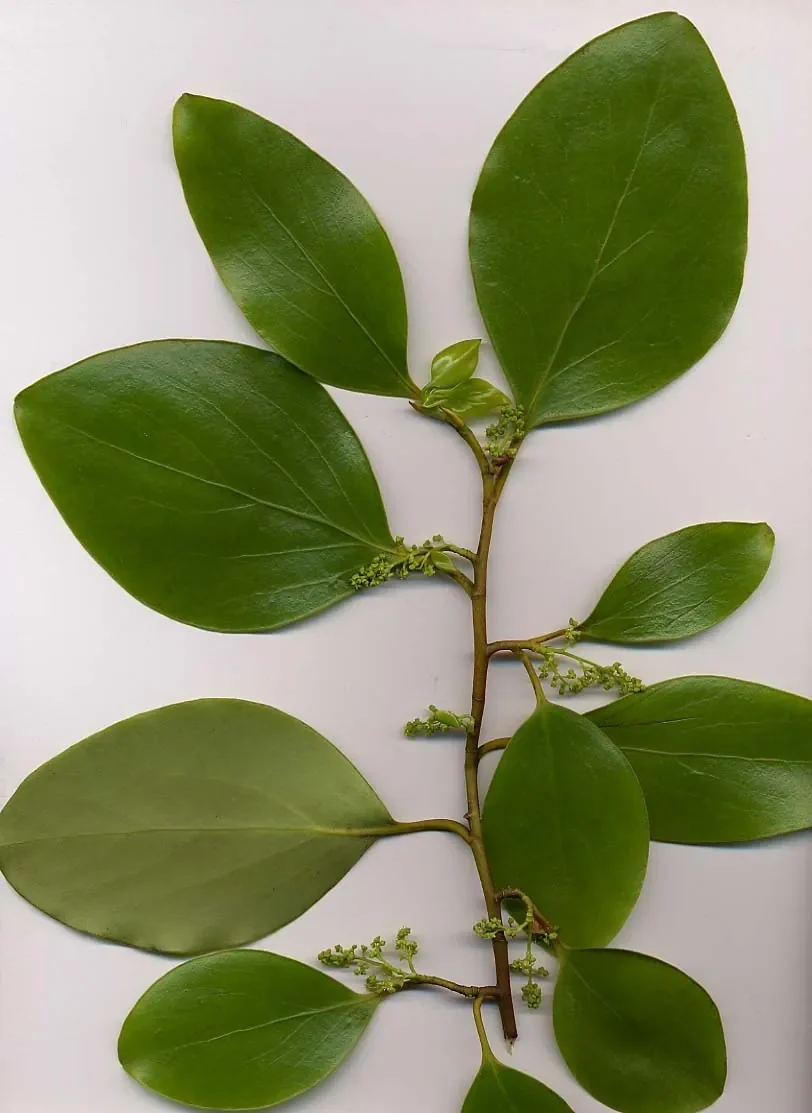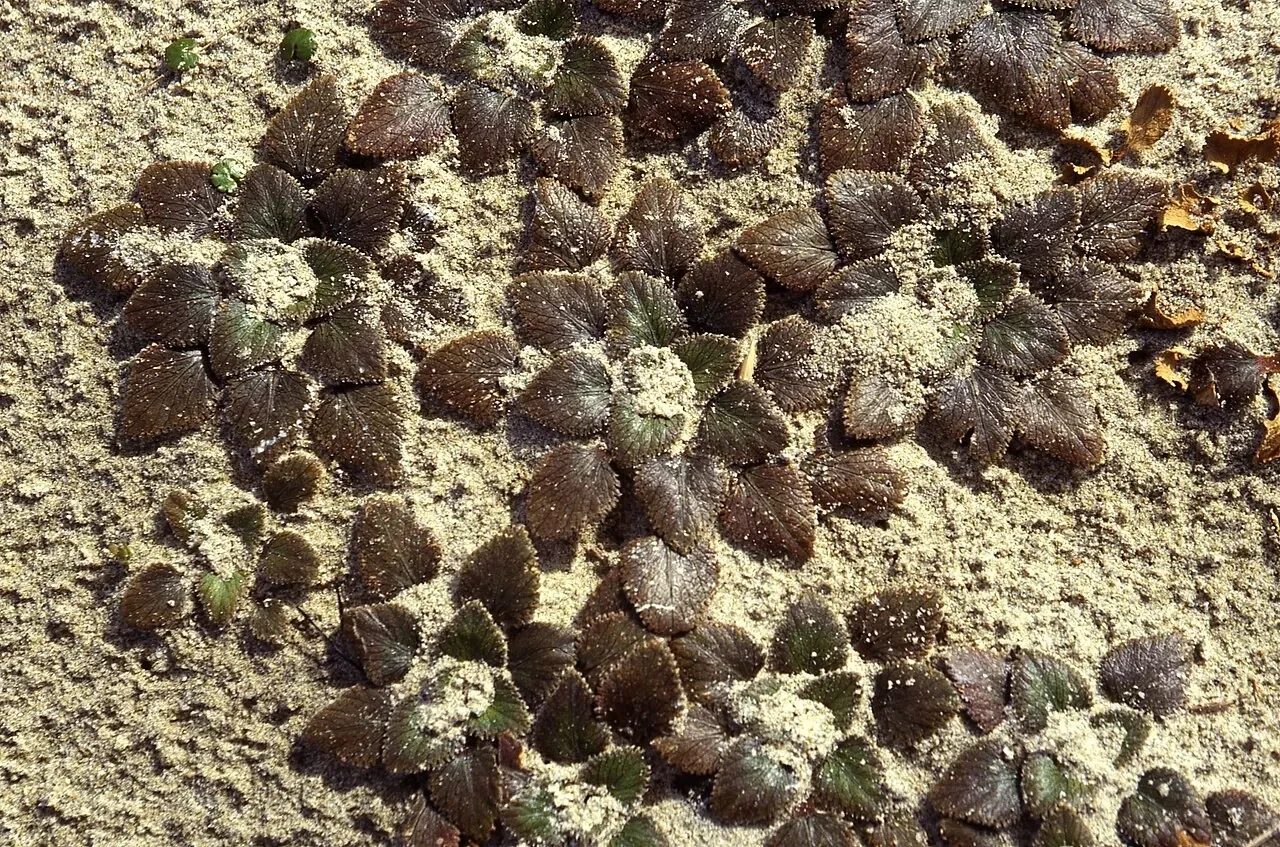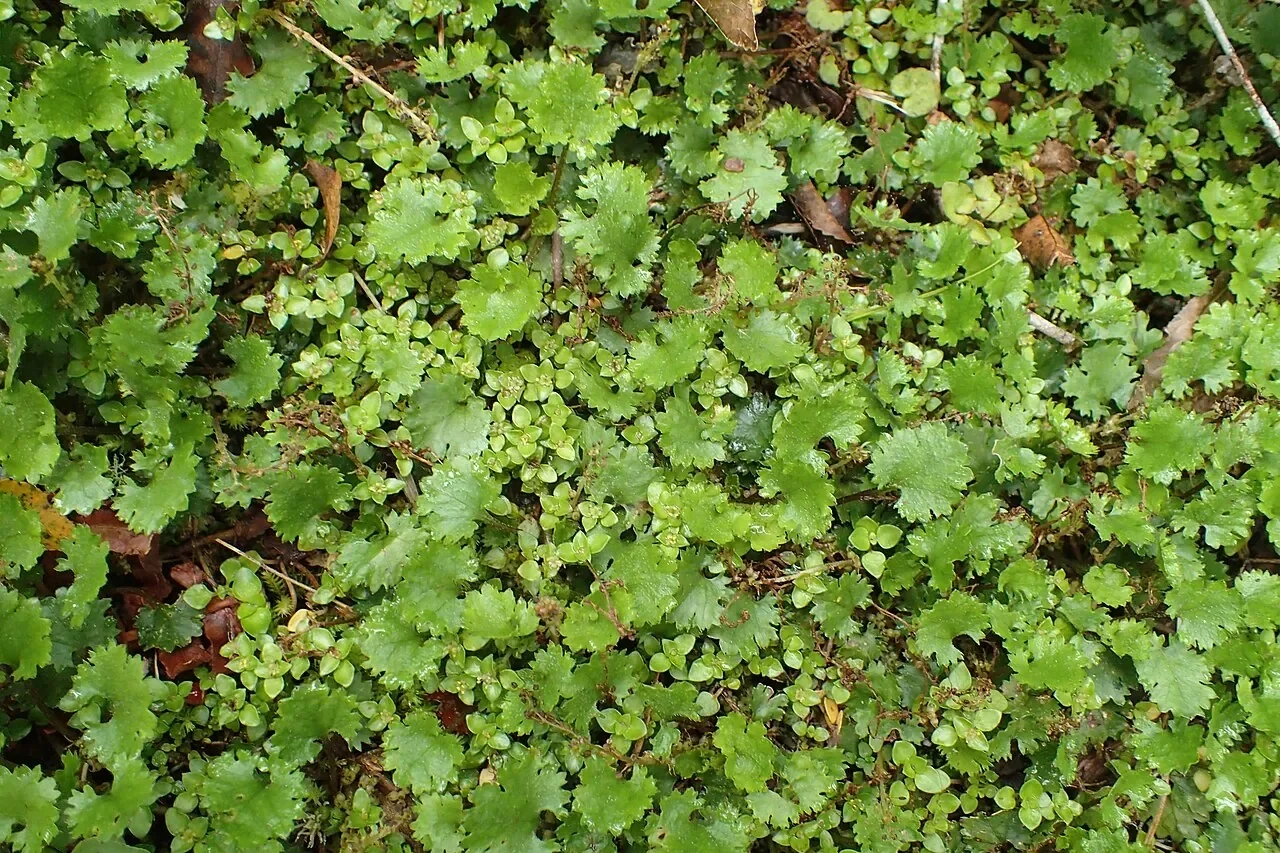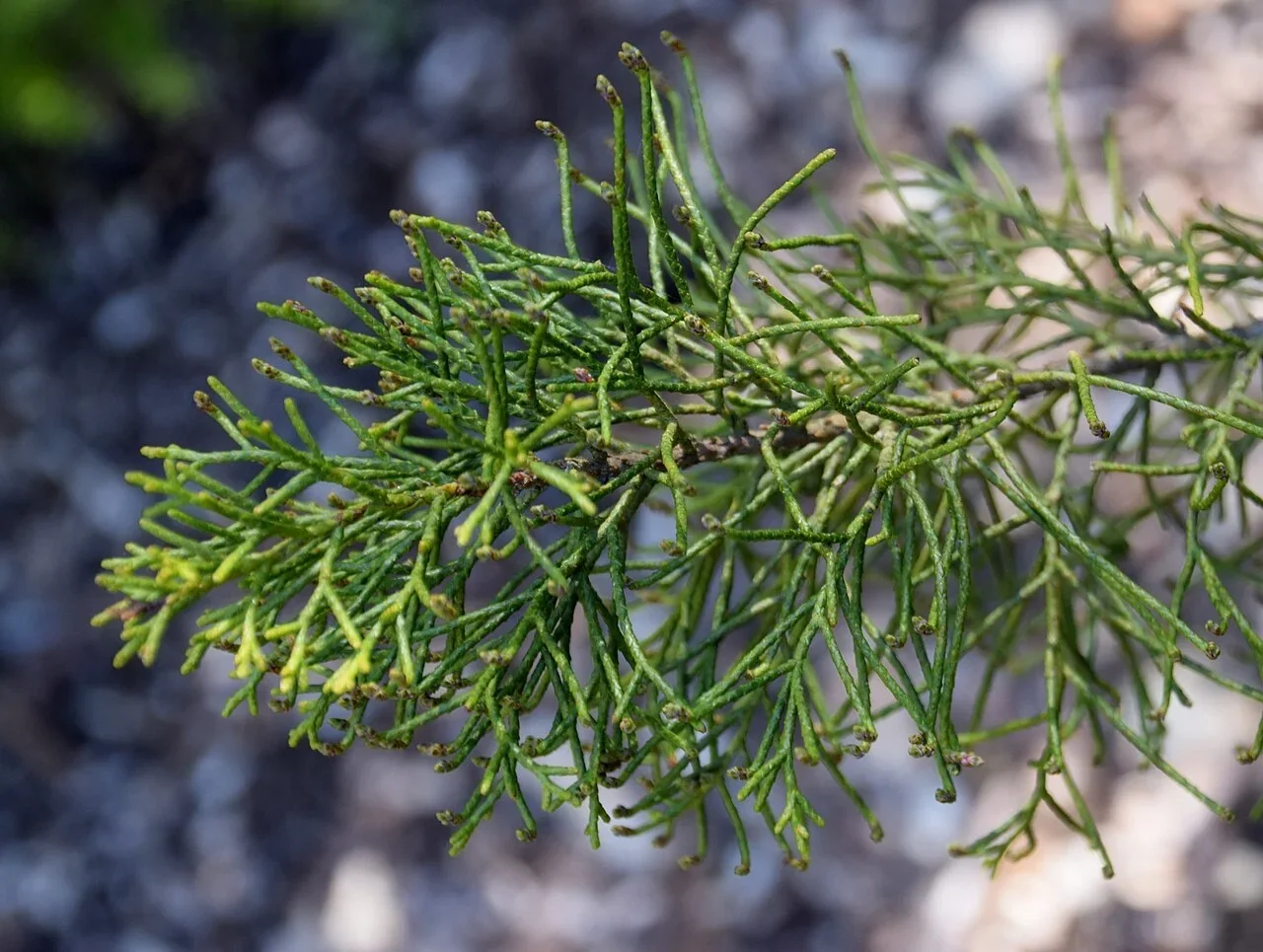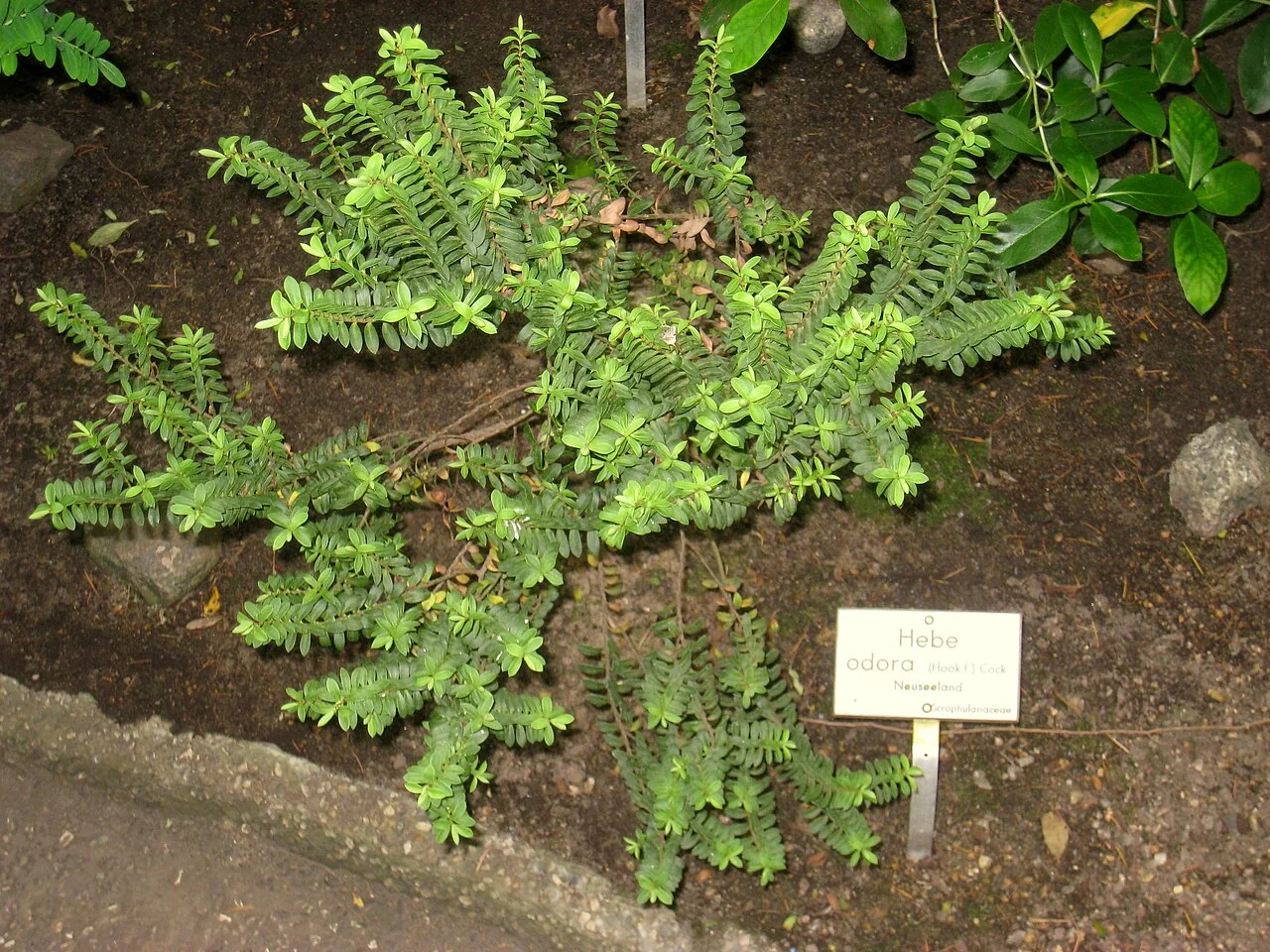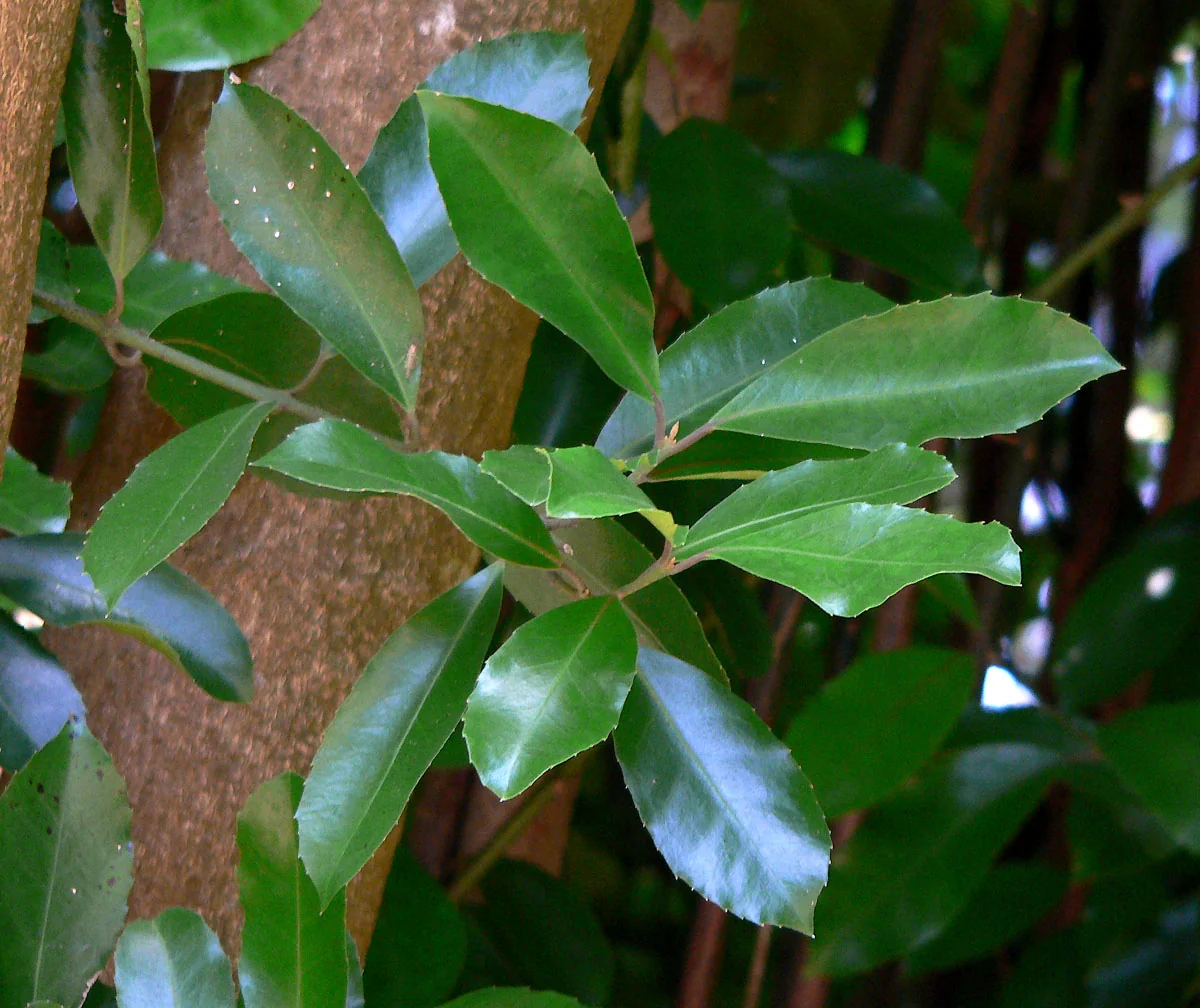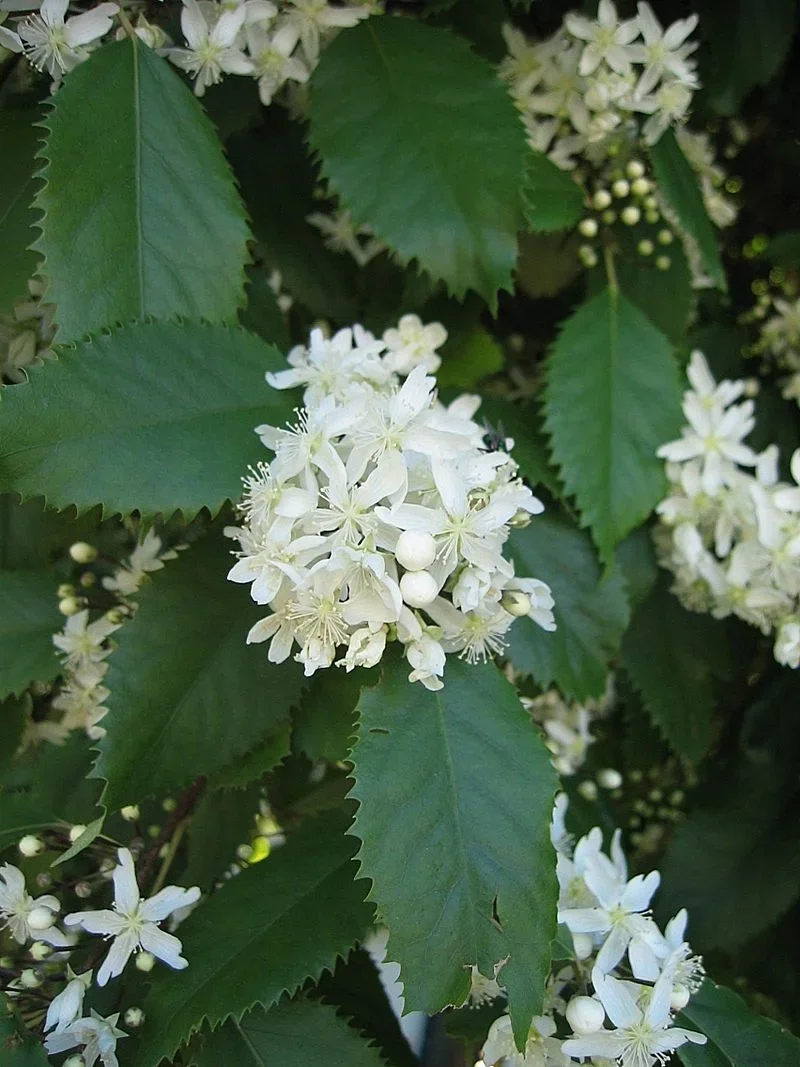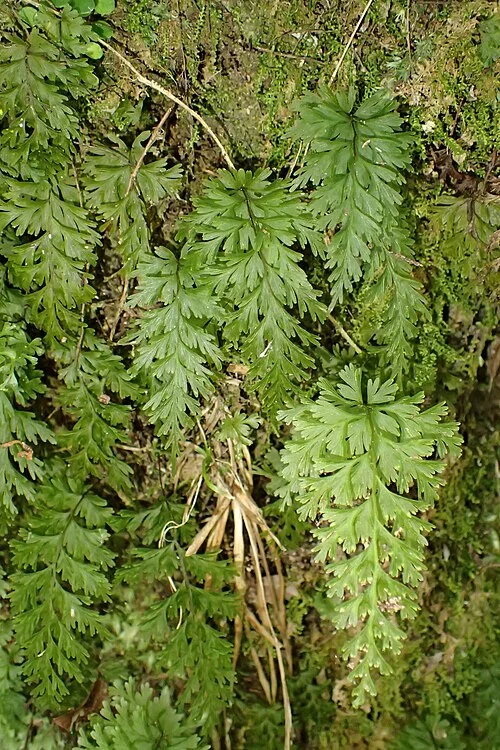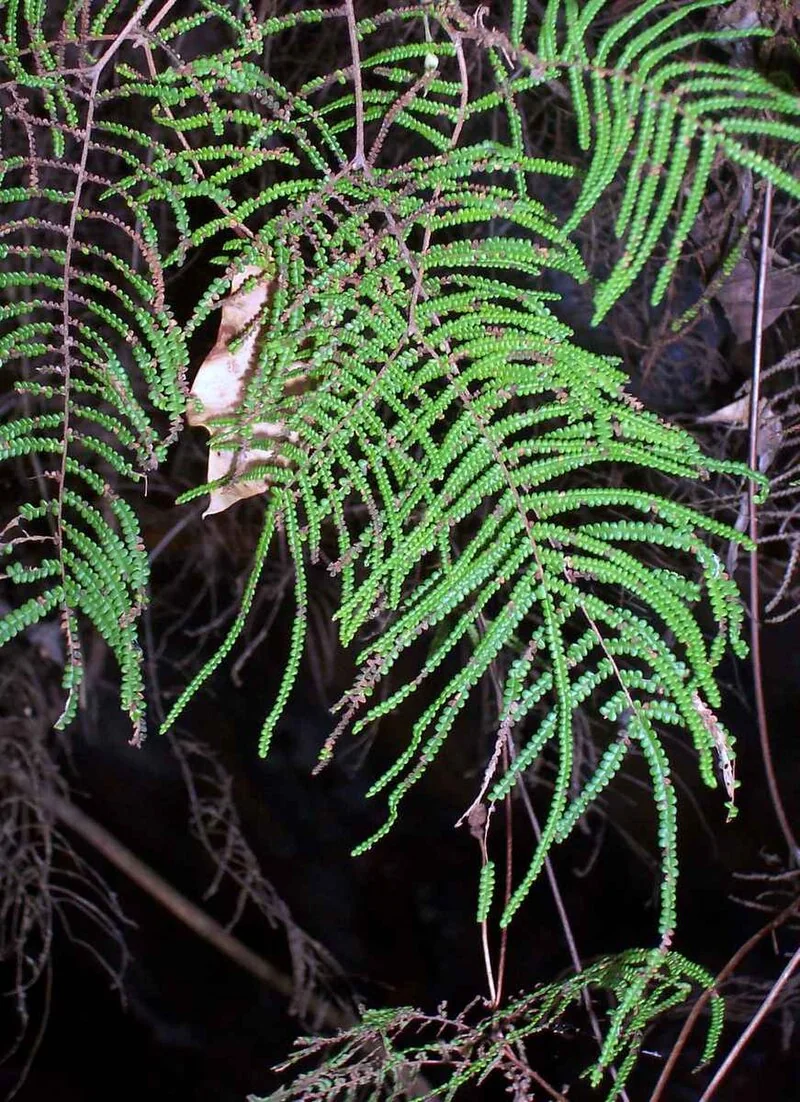
Pouched Coral Fern
Gleichenia dicarpa
Unique Features and Growth Habit
A wiry, scrambling fern forming dense mats in bogs, wet heaths and seepages. Fronds have characteristic "pouched" segments. Requires consistently moist, acidic substrates and open, sunny to lightly shaded positions among our native ferns.

Plant Description
Botanical Features
Gleichenia dicarpa, commonly known as Pouched Coral Fern, Tangle Fern, or Swamp Umbrella Fern, is a small fern found in eastern Australia, New Caledonia, New Zealand, and parts of Southeast Asia. It consists of numerous fronds that grow more or less vertically from a thin, branched rhizome, reaching up to 2 meters in length. The smallest end-branches, called pinnules, are about 1 to 1.5 mm long and have recurved margins, giving them a cup or pouch shape. This pouch shape, which often contains two spores in fertile fronds, is the origin of its common name "pouched coral fern." Fronds in sunnier areas may appear yellowish. This fern typically forms tangled thickets in wet environments such as swamps, riverbanks, peatlands, and under waterfalls. It thrives in nutrient-poor, acidic soils with high humidity and good levels of sunshine and moisture. It spreads by vigorous, much-branched underground stems (rhizomes) and can form extensive tangled colonies.
Quick Facts
Quick Facts Overview
| Scientific Name | Gleichenia dicarpa |
|---|---|
| Height | 0.3-1.0 m |
| Spread | Spreads extensively by rhizomes |
| Light | Sun to light shade |
| Soil | Constantly moist, acidic sands/peat |
| Water Needs | High; never allow to dry out |
| Frost Tolerance | Varies |
| Salt Tolerance | Varies |
| Growth Rate | Varies |
| Lifespan | Varies |
Climate Section
Pouched Coral Fern (Gleichenia dicarpa) naturally occurs in warm temperate to cool temperate climates across eastern Australia, New Zealand, and New Caledonia. It thrives in boggy conditions with high humidity and consistent moisture. The species is adaptable to various climate zones but requires protection from harsh frosts and strong winds. Its preference for acidic, constantly moist environments makes it ideal for regions with regular rainfall or reliable water sources.
Regional Suitability
| City | Climate Suitability |
|---|---|
| Whangārei | Ideal |
| Auckland | Ideal |
| Hamilton | Ideal |
| Tauranga | Ideal |
| Rotorua | Ideal |
| Gisborne | Ideal |
| New Plymouth | Ideal |
| Napier | Ideal |
| Whanganui | Ideal |
| Palmerston North | Ideal |
| Wellington | Ideal |
| Nelson | Ideal |
| Christchurch | Ideal |
| Dunedin | Ideal |
| Invercargill | Ideal |
Plant Habitat
Natural Habitat
Understand the natural habitat of Pouched Coral Fern (Gleichenia dicarpa), including its distribution across bog and wetland environments in New Zealand and beyond. This knowledge is essential for recreating suitable growing conditions and understanding its ecological requirements.
- Natural distribution in New Zealand bogs and wet heaths
- Preferred bog ecosystem characteristics and conditions
- Associated plant communities and bog specialists
- Elevation ranges and climate preferences
- Microhabitat requirements within bog ecosystems
Plant Conservation
The conservation status of Gleichenia dicarpa (pouched coral fern or tangle fern) varies by region but is generally not considered threatened.
In Queensland, Australia, it is listed as "Least concern" under the NCA Status and "Not listed" under the EPBC Status. In New Zealand, its national conservation status was "Not Threatened" as of 2023. Regionally within New Zealand, it is "Regionally Not Threatened" in Auckland (2025) and "Regionally Data Deficient" in Otago (2024). The Yarra Ranges Local Plant Directory in Australia describes it as "Locally common within its preferred growing conditions". It is also noted as "Common and widespread" in badly drained, permanently wet soils in Australia by the Understorey Network.
Growing Requirements
Soil Requirements
Gleichenia dicarpa thrives in acidic, damp, or wet soils, tolerating nutrient-poor conditions. It is adaptable to various soil types including sandy, clay, loamy, sandy loam, and clay loam, but consistently moist conditions are crucial.
- Acidic, damp, or wet soils preferred
- Tolerates nutrient-poor conditions
- Adaptable to sandy, clay, loamy, sandy loam, and clay loam
- Consistently moist to boggy conditions are essential
Light Requirements
This fern prefers sunny locations but can also thrive in part shade. Its fronds particularly favor full sun, though semi-shade is tolerated. In sunnier conditions, the fronds may exhibit a bleached yellow coloration.
- Full sun to part shade
- Fronds favor full sun for best growth
- Semi-shade is tolerated
- Foliage may bleach yellow in intense sun
Water Requirements
Gleichenia dicarpa requires consistently moist to boggy, poorly drained soil. It is well-suited to moist environments with high humidity and benefits from regular watering, about twice weekly, to maintain moisture. Regular misting can also help.
- Consistently moist to boggy soil
- High humidity preferred
- Regular watering (twice weekly) to maintain moisture
- Misting can emulate tropical habitat conditions
Climate and Temperature
Gleichenia dicarpa is found in warm temperate and cool temperate climate zones, with natural distribution across eastern Australia, New Zealand, and New Caledonia. It can tolerate light frost and prefers high humidity.
- Warm temperate to cool temperate climates
- Tolerates light frost
- Prefers high humidity
- Adaptable to tropical to temperate conditions
Planting Guide Section
When to Plant
The ideal time to plant Pouched Coral Fern (Gleichenia dicarpa) is during autumn or spring when temperatures are moderate and natural rainfall is more abundant. These seasons provide optimal conditions for rhizome establishment in boggy conditions.
Site Selection
Choose a site with:
- Constantly moist to boggy soil conditions
- Acidic soil pH (4.5-6.0)
- Full sun to light shade exposure
- Protection from strong winds and harsh frosts
- Good air circulation to prevent fungal issues
- Space for the plant to spread naturally via rhizomes
Planting Procedure
- Prepare a constantly moist, acidic planting area or bog garden
- Amend soil with peat moss, leaf mold, or acidic compost if needed
- Plant rhizome sections just below the soil surface
- Space plantings 30-50cm apart to allow for natural spreading
- Water thoroughly and maintain constant soil moisture
- Apply a thin layer of sphagnum moss or acidic mulch
- Mist regularly to maintain high humidity around new plantings
Initial Care
Keep soil constantly moist to boggy during establishment. New fronds should appear within 4-8 weeks in suitable conditions. Monitor closely for the first growing season to ensure the specialized moisture and acidity requirements are being met.
Ecological Role and Habitat
Ecosystem Role
Hymenophyllum demissum plays a crucial ecological role in New Zealand's forest ecosystems as the most common and widespread filmy fern species. This remarkable plant forms dense carpets on the forest floor, creating microhabitats for countless invertebrates and contributing to the complex layered structure of native forests. Its ability to thrive both terrestrially and as an epiphyte makes it a vital component of forest biodiversity, colonizing everything from rotting logs and rocky outcrops to the trunks of native trees including kauri, rimu, and tree ferns.
The species' remarkable adaptability allows it to inhabit diverse forest types from coastal kauri forests to montane beech forests, making it one of the most ecologically significant ferns in New Zealand's flora. Its wind-dispersed spores enable rapid colonization of suitable habitats, while its ability to form large patches helps stabilize soil and create humid microclimates essential for other forest species.
Uses Section
Garden Uses
- Bog gardens and constructed wetlands
- Pond and water feature margins
- Erosion control on wet slopes
- Native fern collections and ferneries
- Habitat restoration projects
- Container cultivation in constantly moist conditions
Landscaping Section
Design Applications
Discover how Pouched Coral Fern (Gleichenia dicarpa) can create unique and specialized landscape features. This plant excels in bog gardens, naturalistic water features, and conservation projects where authentic wetland environments are desired. Its mat-forming habit provides excellent groundcover in appropriate conditions.
- Bog garden design and construction techniques
- Integration with water features and pond margins
- Companion planting with other bog specialists
- Use in habitat restoration and conservation projects
- Creating authentic wetland landscapes
Seasonal Care
Spring
In spring, Pouched Coral Fern begins active growth with new fronds emerging from rhizomes. This is the ideal time for division and transplanting, as well as establishing new colonies. Ensure consistent moisture and monitor for any winter damage.
- New frond growth begins from rhizomes
- Ideal time for division and propagation
- Check and repair any winter damage to fronds
- Ensure consistent soil moisture as temperatures rise
- Apply organic mulch to maintain soil moisture
Summer
Summer is the peak growing season for Pouched Coral Fern. Spore production occurs during this time, and maintaining consistent moisture becomes critical during hot weather. Regular misting helps replicate natural bog conditions.
- Peak growth period with vigorous frond development
- Spore production and release occurs
- Critical to maintain constant soil moisture
- Regular misting beneficial in hot weather
- Monitor for any signs of drought stress
Autumn
During autumn, Pouched Coral Fern continues active growth as temperatures moderate. This is an excellent time for establishing new plantings, as the cooler, moister conditions support root establishment without summer heat stress.
- Continued active growth in cooler conditions
- Excellent time for new plantings and transplanting
- Spore dispersal continues into early autumn
- Maintain consistent moisture as rainfall increases
- Good time for habitat creation projects
Winter
Winter growth slows significantly for Pouched Coral Fern, though it remains evergreen in mild climates. In colder areas, some fronds may die back, but the rhizome system remains active. Protect from harsh frosts if necessary.
- Growth slows but remains evergreen in mild areas
- Some frond dieback possible in cold regions
- Rhizome system remains active underground
- Protect from harsh frosts in exposed locations
- Maintain soil moisture but reduce active watering
Pruning Section
Techniques and Timing
Pouched Coral Fern (Gleichenia dicarpa) requires minimal pruning, as it naturally maintains its form through continuous growth and natural frond replacement. The primary maintenance involves removing dead or damaged fronds and controlling spread if necessary.
- Remove dead, damaged, or yellowing fronds at any time
- Cut fronds back to the rhizome base with clean, sharp tools
- Control spread by severing rhizome connections if needed
- Thin dense growth to improve air circulation if fungal issues occur
- No regular pruning schedule required - prune as needed
- Old fronds can be left as natural mulch if desired
The fern's natural growth habit creates a self-maintaining colony, with older fronds naturally being replaced by new growth. Any intervention should be minimal to preserve the natural bog ecosystem appearance.
How to Grow Pouched Coral Fern
Pouched Coral Fern is a unique and fascinating native fern that thrives in boggy, wet conditions, making it an excellent choice for specialized bog gardens, wet heaths, and naturalistic pond margins. Its wiry, scrambling fronds and distinctive 'pouched' segments create dense mats that add unique texture and character to wetland environments. While it requires consistently moist, acidic substrates and protection from harsh frosts, its resilience and ecological value make it a rewarding plant to cultivate, especially for those looking to create authentic wetland habitats. Understanding its propagation methods is key to successfully growing this specialized species.
From Rhizome Division
Division of the creeping rhizome system is the most reliable and efficient method for propagating Pouched Coral Fern. This is best undertaken in spring or early autumn when new growth is emerging. Carefully dig up sections of the vigorous rhizome mats, ensuring each piece has several growing points or fronds and intact roots. Cut rhizome sections 10-15cm long with sharp, sterile tools. Plant the divisions immediately into prepared acidic, boggy conditions, ensuring they are just below the soil surface. Keep the substrate constantly moist and provide high humidity. New growth typically appears within 4-8 weeks. This method is excellent for quickly establishing new colonies or expanding existing ones.
From Spores
Propagating Pouched Coral Fern from spores is more challenging but possible for the dedicated grower, requiring very specific conditions to replicate bog environments. Collect fertile fronds when spores are mature, typically in summer. Place the fronds in paper bags to allow spore release. Sow the spores onto a sterile, acidic growing medium, such as a mix of peat and sand. Maintain constant moisture and high humidity around the spores, perhaps by placing them under a plastic dome or in a sealed container. Keep at 18-22°C in bright, indirect light. Germination can occur in 2-4 weeks under ideal conditions, forming a green prothallus, from which tiny fern sporophytes will eventually emerge. Transplant young plants when 2-3cm tall.
Pests Diseases Section
Bog Specialist Care
Pouched Coral Fern (Gleichenia dicarpa) is generally hardy in its preferred bog conditions, but several issues can arise, particularly when grown outside its natural habitat requirements.
Common Problems
- Drought Stress: The most common issue - fronds yellow and die back rapidly if soil dries out even briefly
- Poor Drainage: While needing constant moisture, stagnant water can lead to rhizome rot
- Alkaline Conditions: Chlorosis and poor growth in non-acidic soils
- Low Humidity: Frond edges may brown and crisp in dry air
Potential Pests
- Scale Insects: May occasionally affect fronds, treat with horticultural oil
- Aphids: Can cluster on new growth, usually manageable with water spray
- Slugs and Snails: May damage tender new fronds in humid conditions
Disease Issues
- Fungal Problems: Poor air circulation in very humid conditions can lead to fungal issues
- Rhizome Rot: Can occur in waterlogged, stagnant conditions
Prevention and Management
The best approach is prevention through proper cultural conditions - constant moisture without stagnation, acidic soil, good air circulation, and appropriate light levels. Most problems resolve when optimal bog conditions are maintained.
Cultural Significance
Gleichenia dicarpa, also known as pouched coral fern, tangle fern, spider fern, or swamp umbrella fern, does not have extensive documented cultural significance beyond the origins of its scientific and common names.
The scientific name Gleichenia honors German botanist W.F. von Gleichen, and dicarpa is Ancient Greek for "two fruit," referring to how its spores are held. Common names vary by region, with New Zealanders calling it tangle fern, spider fern, or swamp umbrella fern, while Australians refer to it as pouched coral fern or wiry coral fern.
Historically, Gleichenia dicarpa was first collected by Joseph Banks and Daniel Solander in November 1769 at Mercury Bay in New Zealand, and later officially described by Robert Brown in his 1810 work, Prodromus Florae Novae Hollandiae.
Ecologically, this fern is noted for forming tangled thickets in wet areas and its ability to act as a pioneer species in disturbed ground. Its tangled roots help collect dead plant material and prevent soil erosion. While these ecological roles are significant, specific cultural uses or symbolic meanings are not widely documented for the plant by indigenous populations or other cultures.
Bonus Tip
A Sun-Loving Fern
Unlike most ferns, which prefer shady conditions, the Pouched Coral Fern can tolerate, and even prefers, full sun. This makes it a unique and versatile plant for a native garden, as it can be used in sunny, wet areas where other ferns would not survive. In sunnier spots, the fronds may take on a yellowish hue.
